Discover the Cutting-edge Strategies Made Use Of in a Metal Foundry for Superior Casting Outcomes
In today's affordable manufacturing landscape, metal foundries are increasingly taking on ingenious strategies to enhance spreading outcomes - Aluminum Casting. Advanced computer simulations allow for precise modeling of liquified metal habits, while 3D printing allows rapid production of complex molds. Additionally, eco-friendly products and automation streamline procedures. These growths promise significant renovations in effectiveness and quality assurance. The influence of these technologies on sustainability and manufacturing techniques stays to be totally checked out.
Advanced Computer Simulations in Metal Casting
Advanced computer system simulations have reinvented the metal spreading process by enhancing accuracy and effectiveness. These innovative tools enable engineers to develop virtual designs of cast components, enabling them to assess and predict the actions of molten metal during the casting phase. By simulating various parameters such as temperature, flow rate, and cooling prices, suppliers can identify prospective flaws before physical production starts.
This positive approach lowers waste and lessens costly mistakes, eventually causing enhanced item quality. In addition, simulations facilitate the optimization of mold designs, making sure that they fulfill the certain demands of each task. The combination of computational fluid dynamics (CFD) and limited element evaluation (FEA) further adds to the precision of these simulations, giving insights that were formerly unattainable. Therefore, advanced computer simulations have actually come to be a crucial part of modern metal foundries, substantially progressing the sector's abilities.
3D Printing for Molds and Patterns
3D printing has actually become a groundbreaking method for developing molds and patterns in the metal foundry market. This modern technology enables the quick production of complicated geometries that traditional production techniques have a hard time to accomplish. By using additive production, foundries can create intricate styles with decreased lead times and material waste. The capacity to produce mold and mildews on need allows for higher adaptability in style versions, facilitating faster prototyping and modifications.
Moreover, 3D printing can make use of a selection of materials, consisting of metals and plastics, tailored to particular casting demands. This flexibility improves the precision of mold and mildews, resulting in exceptional casting end results with boosted surface area coatings. Additionally, the decrease in the variety of parts called for streamlines setting up procedures, additionally maximizing manufacturing performance. As foundries continue to embrace 3D printing, they are poised to redefine market criteria, paving the way for innovation and boosted productivity in metal spreading operations.
Eco-Friendly Materials and Processes
As the metal foundry sector faces raising stress to reduce its environmental impact, the adoption of environmentally friendly products and procedures has actually ended up being necessary. Shops are currently checking out lasting choices to conventional materials, such as utilizing recycled steels and bio-based binders. These materials not only minimize waste but also reduced power consumption during production.
Furthermore, improvements in sand casting methods have actually caused making use of synthetic sands that are less damaging to the environment. Factories are likewise implementing cutting-edge procedures like liquified metal therapy that decreases discharges and enhances the quality of cast items.
Additionally, water-based coatings have actually changed hazardous solvents, promoting a safer workplace (Aluminum Foundry). By incorporating these environment-friendly methods, metal foundries can noticeably reduce their environmental effect while keeping high-quality spreading results. This change not only profits the setting but also straightens with the expanding customer need for sustainable manufacturing remedies
Automation and Robotics in Foundry Procedures
While the metal foundry sector welcomes development, the combination of automation and robotics is changing operations substantially. Automated systems streamline procedures such as mold and mildew production, metal putting, and casting completing, substantially boosting effectiveness. Robotics help with the handling of hefty products, decreasing the danger of work environment injuries and making sure much safer environments.

Additionally, using automated guided vehicles (AGVs) maximizes material transportation within facilities, making sure timely delivery of components i loved this to appropriate workstations. By carrying out these modern technologies, foundries can adapt to changing demands with higher agility, inevitably leading to boosted profitability and competition in the marketplace. As automation and robotics remain to develop, they hold the potential to redefine conventional foundry techniques and drive more innovations in casting strategies.
Real-Time Surveillance and Top Quality Control Techniques
The advancements in automation and robotics have actually paved the way for extra sophisticated approaches to quality control in metal foundries. Real-time tracking systems use innovative sensing units and information analytics to track important parameters throughout the spreading process. These systems continuously assess variables such as material, stress, and temperature composition, allowing immediate discovery of variances from developed standards.
Quality assurance techniques now incorporate artificial intelligence formulas that analyze historic information to anticipate prospective issues before they happen. This proactive method minimizes waste and enhances total production efficiency. In addition, incorporated comments loopholes permit for quick changes, making certain that each casting satisfies strict high quality demands.
The implementation of electronic doubles-- digital replicas of physical properties-- has additionally revolutionized quality control, allowing designers to mimic and maximize procedures in real-time. Together, these ingenious strategies greatly improve the integrity and quality of spreadings, setting new industry requirements in metal foundry procedures.
Often Asked Questions
What Sorts of Metals Are Frequently Cast in Factories?
Generally cast metals in foundries consist of light weight aluminum, brass, iron, and bronze. Each metal exhibits special properties, making them suitable for different applications, such as vehicle components, machinery, and imaginative sculptures, boosting their flexibility in manufacturing.

Exactly how Lengthy Does the Casting Process Commonly Take?
The spreading procedure generally takes a number of hours to days, depending on factors such as the complexity of the mold and mildew, kind of metal made use of, and air conditioning needs. Each stage influences the overall more period significantly.
What Precaution Are in Place for Foundry Employees?

How Are Issues in Castings Identified and Addressed?
Flaws in castings are recognized through aesthetic inspections and non-destructive screening methods. When identified, foundry workers address them by fine-tuning procedures, readjusting product compositions, and carrying out rehabilitative steps to guarantee high quality and compliance with requirements.
What Is the Cost Variety for Metal Casting Services?
The cost array for metal spreading services commonly differs between $1 to $10 per pound, relying on elements such as material kind, complexity of the design, and production volume, impacting total prices significantly.
In today's competitive production landscape, metal foundries are significantly embracing ingenious methods to enhance casting results. As the metal foundry industry deals with enhancing stress More about the author to lower its environmental footprint, the fostering of environmentally friendly materials and processes has actually ended up being vital. Factories are now exploring lasting options to traditional products, such as utilizing bio-based binders and recycled metals. By incorporating these eco-friendly techniques, metal foundries can markedly lower their eco-friendly impact while maintaining top quality casting results. The advancements in automation and robotics have actually led the means for a lot more sophisticated strategies to top quality assurance in metal foundries.